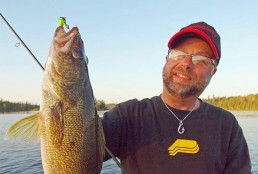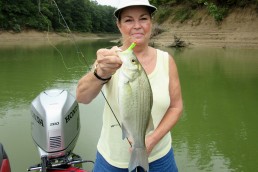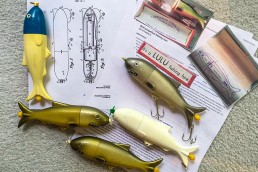Imitation or Real, Worms Work Walleye Wonders in Open Water
SHARE THIS POST
They wiggle. They squiggle. They’re soft and smell funny—they’re worms. And all that holds true whether they are modern-day fake baits or the real deal. The best thing about worms is they work wonders when it comes to catching walleyes in open water. But not all are created equal.
Not even the live ones.
Dive right in
What is it about worms that work so well for catching walleyes? Well, you don’t have to dive too deeply in thought to figure it out. Like all fish, walleyes are opportunistic feeders. They’ll eat whatever passes by when they are in the mood to feed.
What about all those minnows and bugs walleyes are feasting on all summer? They are still feeding on those, but the cool thing about worms is you can change their appearance by adding a little bling to your rig, or just double them up or nip them in half. And, you can fish them fast, slow and at all speeds in between—and the fish like the way they taste.
The livelier the better
You’d be hard-pressed not to find live nightcrawlers in my boat anytime I’m on the water, but lethargic, lifeless ‘crawlers won’t cut it. In fact, dying worms skewered onto a hook will repel fish rather than entice them into taking a bite. ‘Crawlers must be kept cool and moist, and not too wet. When purchased, most nightcrawlers are packed in rich, black dirt. They should be kept in this natural mixture for long-term storage over a period of months to get nourishment. And they need to be kept cool; store them in a room in the mid-40s. For shorter-term use, Frabill’s Fat & Sassy Pre-Mixed Worm Bedding is ideal. Best of all, it comes pre-moistened with just the right amount of water added.
When bringing along worms for the day, I keep them in an insulated container. The foamed liner does two things: it keeps the temperature inside consistently cool and acts as a shock absorber during travel in my vehicle and boat. Worms, no matter the type, will parish quickly if jostled around too much. And when on board, I’ll keep the insulated container in a cooler rather than add ice inside it. When the ice melts it can saturate the bedding and eventually kill the ‘crawlers.
For long-term storage of worms, I’ll transfer them into Frabill’s Habitat V Worm Storage System. This unit will hold dozens of huge nightcrawlers without overcrowding the herd, which can also lead to premature death.
Are you enjoying this post?
You can be among the first to get the latest info on where to go, what to use and how to use it!
Real vs. imitation
Whether I use live ‘crawlers or soft baits that imitate the real thing, it is usually up to the fish. And knowing when to use one over the other comes from trial and error. Seeing that I have confidence in live and imitation worms, I rarely start using one over the other. Instead, I base my choice on the environment of the waterway, my technique and other species that reside in it. An example is when perch are present and pecking away at my live nightcrawlers on a ‘crawler harness, nipping away at the meat until it’s completely gone off the hook. This is when I’ll change up and use Gulp Nightcrawlers instead of live ones. The Gulp ‘crawlers are soft, yet tough enough that small fish can’t tear them apart before walleyes get a chance to take a poke at them, and these expel a scent that predator fish love.
When casting and jigging though, I’ll often start out with soft baits, as they stay on the hook better when being ripped through structure like weeds, wood and rock. Berkley’s 4-inch PowerBait Power Worm, as well their newly reintroduced Pro Jig Worm, are two of my go-to baits when walleyes are in vegetation. I skewer them onto a 1/8- to 1/4-ounce Metallic Eye-Ball Jig. This particular model has a barbed-wire worm and grub barb on it that holds the bait in place, snug to the head.
Changing form
As I mentioned, worms work wonders on walleyes focused on eating other forage. A spinner blade above a nightcrawler, such as one on a ‘crawler harness, gives off the flash and vibration walleyes love. Any time I’m pulling harnesses, whether high in the water column behind in-line planer boards or near the bottom behind bottom-bouncers, I’ll rig a nightcrawler onto a spinner harness. The blade on this rig has lifelike images of minnows and small fishes imprinted on them and look like the real thing.
If walleyes are feeding on insects like mayfly nymphs, I’ll use smaller blades and only half a worm on a single-hook spinner rig. Walleyes are more likely to take a bite at my bait if it’s been shrunk down when they are feasting on the bugs.
Worms also imitate the small lampreys that walleyes often eat during midsummer. In rivers, for example, I’ll just nip the nose of a nightcrawler onto a razor-sharp Daiichi hook without any spinner ahead of it. If the water’s dirty and I feel a little color is needed to attract attention, I’ll slip one to three, small, brightly colored beads ahead of the hook. Just pinch a couple split shot a few feet above the hook or tie up a slip-sinker rig and hang on.
Worm roundup
The only problems I know of when it comes to using worms—live or imitation—are the endless ways in which to rig them for the fishing situation at hand. Above are only a mere few, just to get you thinking. When it comes to using worms, let your imagination run wild. Just remember to keep your live ones “lively” and use soft baits that smell like the real thing. Do so, and you’ll catch fish on them all summer. After all, the best thing about worms is they work wonders when it comes to hoodwinking walleyes in open-water.
Mark Martin is a professional walleye tournament angler and instructor with the Ice- Fishing School/Vacation series. Check out his website at markmartins.net or fishingvacationschool.com for more information.
MWO
SHARE THIS POST
You may also like...
Did you enjoy this post?
You can be among the first to get the latest info on where to go, what to use and how to use it!
Mark Martin
Mark Martin is a professional walleye tournament angler and instructor with the Ice Fishing School/Vacation series. For more information, check out his website at markmartins.net or fishingvacationschool.com.



